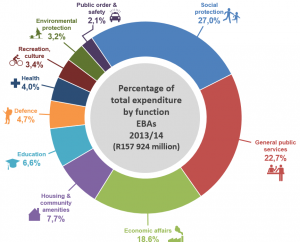
Extra-budgetary institutions focus their spending on social protection
Stats SA’s latest extra-budgetary accounts (EBA) statistical release contains economically and functionally classified financial data on 233 funds for the 2013/14 fiscal year.
EBAs do not operate through normal parliamentary budgetary processes, but they perform an integral role in delivering services of the national government. Some examples of EBAs include the South African Revenue Service, the Commission for Conciliation, Mediation and Arbitration, the Road Accident Fund, and the Unemployment Insurance Fund.
The EBA publication indicates both the economic and functional effect of EBA spending, reflecting the extent of the cost of certain functions (e.g. health, education, social protection, construction, transport and communication) against their economic impacts (e.g. salaries and wages).
Some key findings from the latest EBA report were:
For the 2013/14 fiscal year ending 31 March 2014, cash receipts from EBA operating activities amounted to R178 869 million, while their cash payments for operating activities and purchases of non-financial assets amounted to R157 924 million.
The largest contributors to total EBA expenditure in 2013/14 were social protection, general public services, economic affairs, and housing and community amenities.
Examples of increased EBA expenditure from 2012/13 to 2013/14 include the following:
Social protection: The increase of R9 857 million in cash payments for social protection from R32 824 million in 2012/13 to R42 681 million in 2013/14 can be attributed to higher claims paid by the Road Accident Fund, the Unemployment Insurance Fund and the South African Social Security Agency.
Education and basic research: The increase of R1 229 million in cash payments for education from R9 179 million in 2012/13 to R10 408 million in 2013/14 was mainly due to increased cash payments by the National Skills Fund, the Services Sector Education and Training Authority, and the National Student Financial Aid Scheme. This was for the granting of loans and bursaries to eligible students attending public higher educational institutions, as well as public technical and vocational education and training infrastructure development and bursary support for unemployed learners.
The increase of R815 million in cash payments for basic research from R3 639 million in 2012/13 to R4 454 million in 2013/14 was mainly due to increased cash payments by the National Research Foundation, the South African National Space Agency and the Technology Innovation Agency.
Recreation, culture and religion: The increase of R2 602 million in cash payments for recreation, culture and religion from R2 804 million in 2012/13 to R5 406 million in 2013/14 was mainly due to increased cash payments by the National Lottery Distribution Trust Fund, the Gauteng Cradle of Humankind and the National Lotteries Board.
Environmental protection: The increase of R935 million in cash payments for environmental protection from R4 187 million in 2012/13 to R5 122 million in 2013/14 was mainly due to increased cash payments by South African National Parks, the South African National Biodiversity Institute and the KwaZulu-Natal Nature Conservation Board.
For more detailed information, please download the full report here.


